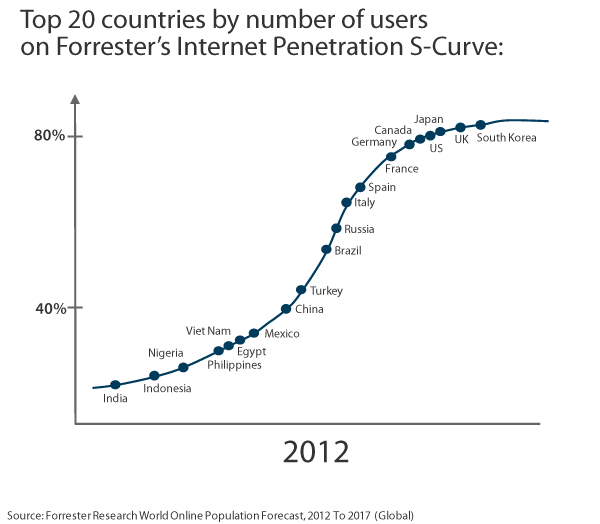The World Online Population Is Expected To Reach 3.5 Billion By 2017
In 1974, an Indian Bollywood Hindi-language film was released with the title Roti Kapda Aur Makaan (English translation: Food, Clothing, And Shelter), referring to the bare minimums of life. If it were to be released today, the director of the movie would need to add the word Internet to the title because access to the Internet has become a necessity for many people over the past decade.
In a recently published Forrester ForecastView report titled “Forrester Research World Online Population Forecast, 2012 To 2017 (Global),” Forrester found that 2.4 billion people across the world use the Internet on a regular basis — i.e., at least once a month — from home, school, work, or any other location via a PC or a non-PC (mobile) Internet access device. This is expected to grow to 3.5 billion by 2017, representing nearly half of the 2017 overall world population of 7.4 billion. Our forecast provides the details of the Internet population in 56 countries across five regions.
In some countries — mostly developed economies, such as the US, the UK, Japan, Germany, Sweden, and the Netherlands — Internet penetration as a percent of the overall population is very high; more than 80% of the population are regular Internet users. In other, mostly emerging markets — such as Brazil, Russia, India, China, Mexico, Indonesia, the Philippines, and Nigeria — Internet penetration ranges between 10% and 50%. A key point to note is that while higher PC penetration has driven the adoption of Internet in developed economies during the past two decades, faster mobile penetration in the emerging economies is helping increase the Internet population, thanks to “mobile-only” Internet users.
The figure below shows the relative position of the top 20 countries by the number of Internet users in 2012 on our Internet penetration S-curve. Because it looks at the number of users, some smaller European countries, such as Sweden, Denmark, Norway, Finland, the Netherlands, and Switzerland, are not represented, despite Internet penetration rates of 83% or more.

As we move toward 2017, most of the laggard countries will move up the curve as Net access becomes more pervasive. The speed at which a particular country moves up the curve will depend on a number of factors, such as:
- The affordability of Internet services or Internet access devices.
- The education/skills of the users.
- The interest/motivation of the users.
- Internet connectivity (i.e., fixed broadband and mobile).
- The country’s infrastructure (i.e., telephone lines and international bandwidth).
- The government’s vision of the country’s digital future and related policies.
In your opinion, what are the Top-3 drivers for the online population growth of a country? We’d also love to hear your thoughts on how higher Internet penetration helps the growth of an economy.
